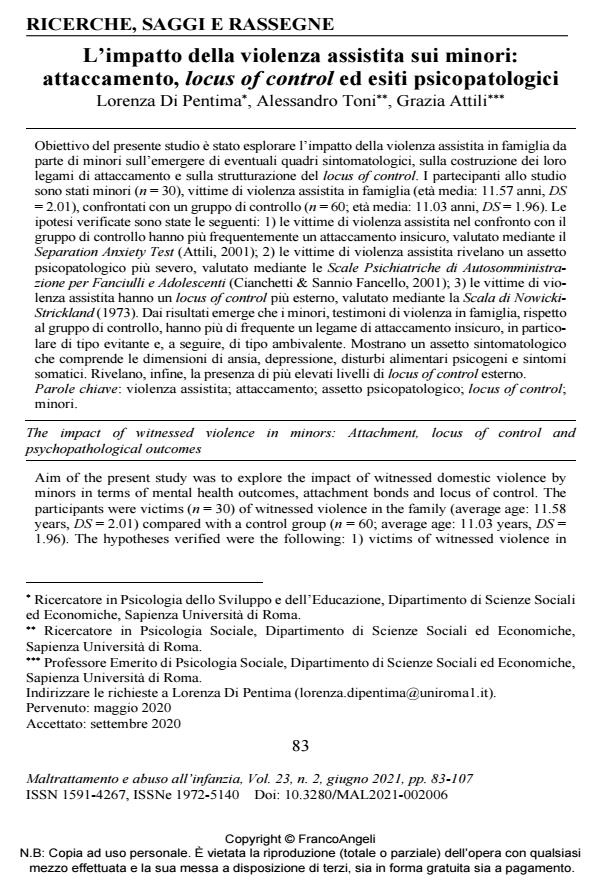L’impatto della violenza assistita sui minori: attaccamento, locus of control ed esiti psicopatologici
Titolo Rivista MALTRATTAMENTO E ABUSO ALL’INFANZIA
Autori/Curatori Lorenza Di Pentima, Alessandro Toni, Grazia Attili
Anno di pubblicazione 2021 Fascicolo 2021/2
Lingua Italiano Numero pagine 25 P. 83-107 Dimensione file 271 KB
DOI 10.3280/MAL2021-002006
Il DOI è il codice a barre della proprietà intellettuale: per saperne di più
clicca qui
Qui sotto puoi vedere in anteprima la prima pagina di questo articolo.
Se questo articolo ti interessa, lo puoi acquistare (e scaricare in formato pdf) seguendo le facili indicazioni per acquistare il download credit. Acquista Download Credits per scaricare questo Articolo in formato PDF

FrancoAngeli è membro della Publishers International Linking Association, Inc (PILA)associazione indipendente e non profit per facilitare (attraverso i servizi tecnologici implementati da CrossRef.org) l’accesso degli studiosi ai contenuti digitali nelle pubblicazioni professionali e scientifiche
Obiettivo del presente studio è stato esplorare l’impatto della violenza assistita in famiglia da parte di minori sull’emergere di eventuali quadri sintomatologici, sulla costruzione dei loro legami di attaccamento e sulla strutturazione del locus of control. I partecipanti allo stu-dio sono stati minori (n = 30), vittime di violenza assistita in famiglia (età media: 11.57 an-ni, DS = 2.01), confrontati con un gruppo di controllo (n = 60; età media: 11.03 anni, DS = 1.96). Le ipotesi verificate sono state le seguenti: 1) le vittime di violenza assistita nel con-fronto con il gruppo di controllo hanno più frequentemente un attaccamento insicuro, valu-tato mediante il Separation Anxiety Test (Attili, 2001); 2) le vittime di violenza assistita rive-lano un assetto psicopatologico più severo, valutato mediante le Scale Psichiatriche di Au-tosomministrazione per Fanciulli e Adolescenti (Cianchetti & Sannio Fancello, 2001); 3) le vittime di violenza assistita hanno un locus of control più esterno, valutato mediante la Sca-la di Nowicki-Strickland (1973). Dai risultati emerge che i minori, testimoni di violenza in famiglia, rispetto al gruppo di controllo, hanno più di frequente un legame di attaccamento insicuro, in particolare di tipo evitante e, a seguire, di tipo ambivalente. Mostrano un assetto sintomatologico che comprende le dimensioni di ansia, depressione, disturbi alimentari psi-cogeni e sintomi somatici. Rivelano, infine, la presenza di più elevati livelli di locus of con-trol esterno.
Parole chiave:violenza assistita; attaccamento; assetto psicopatologico; locus of control; minori.
- Dysfunctional Parental Care and Emotional Dysregulation: A Pilot Study on the Mediating Role of Attachment Styles and Alexithymia in a Sample of Young Women Lorenza Di Pentima, Alessandro Toni, in Journal of Adult Development /2025
DOI: 10.1007/s10804-025-09523-z
Lorenza Di Pentima, Alessandro Toni, Grazia Attili, L’impatto della violenza assistita sui minori: attaccamento, locus of control ed esiti psicopatologici in "MALTRATTAMENTO E ABUSO ALL’INFANZIA" 2/2021, pp 83-107, DOI: 10.3280/MAL2021-002006